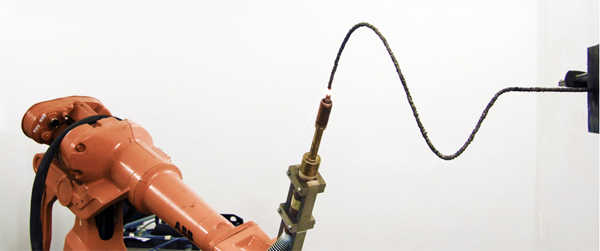Joris Laarman Lab Presents Freeform Metal 3D Printing

MX3D can build lines in midair from molten metal. Courtesy of Joris Laarman Lab.
Latest News
February 25, 2014
Additive manufacturing (AM) is an amazingly flexible tool. It can construct complex objects during the course of a single build that would normally require multiple other traditional manufacturing processes. No matter how remarkable, however, every technology comes with a few limitations.
For AM, one limitation is the static nature of 3D printers. While the object inside an AM system might be able to take almost any shape, the printer itself must sit still in one place to produce that object. The Joris Laarman Lab has been working on more freeform versions of AM, last year with a resin/plastic based system, and this year working with metals.

The MX3D metal AM system looks exactly the same as its resin/plastic forebearer. The process uses a precision robotic arm to control the movements of a 3D printing head, which, in this case, extrudes metal droplets that fuse together to create solid lines. The metal formations can be built in gentle curves, as well as straight lines, and can start on any surface, vertical, horizontal or somewhere in-between, without requiring support materials.
From the website:
After developing our MX3D-resin printer last year we again used an industrial robot, but now together with an advanced welding machine we are able to print with metals, such as steel, stainless steel, aluminium, bronze or copper without the need for support-structures. By adding small amounts of molten metal at a time, we are able to print lines in mid air.
As of now, the design process isn’t particularly user friendly, but the Lab is working on making a UI that can print directly from CAD. If you look closely at the picture, you might also notice that the lines drawn by the MX3D are somewhat lumpy in appearance. Smoothing out the material during fabrication is another area the design group will be focusing on as the MX3D moves forward from laboratory prototype to functional design.
Assuming the team can get the wrinkles ironed out, including the possibility of a less expensive driver for the MX3D than a robotic arm, the ability to print on the fly, as it were, has potential. One area in which I could see the 3D printer being used is in construction. Instead of printing an object in one place and transporting it to the construction site to be nailed in place, the MX3D could simply create whatever object was needed, wherever it was needed.
Below you’ll find a short video demonstration of the MX3D. You can also see the system at work for yourself when it’s on display at the Friedman Benda gallery in New York from May 1 to June 7.
Source: Joris Laarman Lab
Subscribe to our FREE magazine, FREE email newsletters or both!
Latest News
About the Author
John NewmanJohn Newman is a Digital Engineering contributor who focuses on 3D printing. Contact him via [email protected] and read his posts on Rapid Ready Technology.
Follow DE





